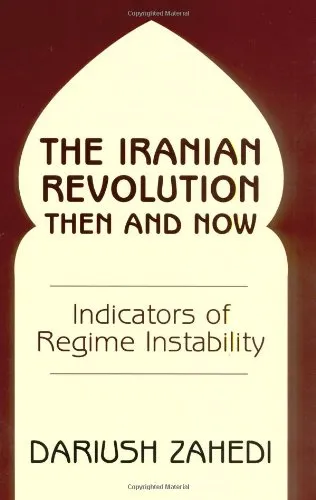The Iranian Revolution Then and Now: Indicators of Regime Instability
4.0
بر اساس نظر کاربران

شما میتونید سوالاتتون در باره کتاب رو از هوش مصنوعیش بعد از ورود بپرسید
هر دانلود یا پرسش از هوش مصنوعی 2 امتیاز لازم دارد، برای بدست آوردن امتیاز رایگان، به صفحه ی راهنمای امتیازات سر بزنید و یک سری کار ارزشمند انجام بدینمعرفی کلی کتاب
کتاب «The Iranian Revolution Then and Now: Indicators of Regime Instability» به قلم داریوش زاهدی، به بررسی عمیق انقلاب ایران و تاثیرات آن بر پایداری رژیمهای سیاسی در جمهوری اسلامی ایران میپردازد. زاهدی با تحلیل جامع و دقیق خود، به خوانندگان چشماندازی نو از فهم انقلاب ۱۳۵۷ و پیامدهای آن بر ساختار سیاسی این کشور ارائه میدهد.
خلاصهای جامع از کتاب
کتاب به چند بخش اصلی تقسیم میشود که هر کدام به جنبههای مختلفی از انقلاب ایران و پایداری رژیم پرداختهاند. نویسنده با استفاده از روشهای علمی و آنالیز دادهها، تلاش میکند تا یک مدل تئوریک برای فهم ناپایداری سیاسی ایران ارائه دهد. زاهدی ضمن بررسی تحولات سیاسی، اقتصادی، و اجتماعی کشور پیش و پس از انقلاب، به ارزیابی چالشهای مختلفی میپردازد که جمهوری اسلامی با آنها مواجه است.
زاهدی از نظریههای مختلفی استفاده میکند تا توضیح دهد چگونه تغییرات ساختاری در جامعه و سیاست ایران، منجر به ناپایداری رژیم شده است. او به بررسی فاکتورهای متغیری مانند اقتصاد نفتی، تحریمها، کشمکشهای داخلی و خارجی پرداخته و نتیجهگیری میکند که علیرغم تغییرات ظاهری، ناپایداریهایی بنیادین همچنان در زیر پوست جامعه ایرانی باقی مانده است.
نکات کلیدی
- تحلیل جامع ناپایداری سیاسی در ایران پس از انقلاب
- بررسی اثرات اقتصاد نفتی بر روی سیاستهای داخلی و خارجی
- تحلیل تاثیر تحریمهای اقتصادی بر پایداری رژیم
- ارزیابی چالشهای اجتماعی و جمعیتی در ایران
نقلقولهای معروف
"انقلاب ایران نه تنها تغییرات ساختاری گستردهای به همراه داشت، بلکه بنیانهای روانشناختی جامعه ایرانی را نیز تحت تأثیر قرار داد."
اهمیت کتاب
کتاب «The Iranian Revolution Then and Now: Indicators of Regime Instability» به دلیل تحلیل دقیق و جامع خود از وضعیت سیاسی و اجتماعی ایران، یکی از منابع مهم برای پژوهشگران و علاقهمندان به سیاست خاورمیانه به شمار میآید. این کتاب با ارائه یک مدل تئوریک از ناپایداری سیاسی، توانسته است دریچهای نو به فهم بهتر چالشها و فرصتهای پیش روی جمهوری اسلامی ایران بگشاید. مطالعه آن برای کسانی که به آینده سیاسی ایران و وضعیت منطقهای آن علاقهمندند، بسیار توصیه میشود.
Welcome to an in-depth exploration of one of the most significant political upheavals in the late 20th century — the Iranian Revolution. My book, "The Iranian Revolution Then and Now: Indicators of Regime Instability," delves into the intricate socio-political dynamics leading up to and following the revolution, providing a comprehensive analysis of factors that have historically contributed to regime instability in Iran.
Detailed Summary of the Book
The book meticulously traces the roots of the 1979 Iranian Revolution, exploring the complex interplay of socio-economic, political, and ideological forces that culminated in the rise of the Islamic Republic. It revisits the pivotal moments that characterized the overthrow of the Pahlavi monarchy, examining the role of key figures, the influence of revolutionary ideologies, and the mobilization of diverse social groups.
Additionally, the narrative extends beyond historical recounting, offering a critical analysis of the post-revolutionary period. It scrutinizes the structural and political transformations within the new regime and explores how these changes have manifested in terms of systemic vulnerabilities and persistent challenges. The study incorporates an array of indicators, including economic discontent, political dissent, and international pressures, to explore their contributions to the ongoing discourse on regime stability in contemporary Iran.
Key Takeaways
- Historical Context: Gain insights into the socio-political conditions of pre-revolutionary Iran and the events leading up to the seismic shift in power.
- Analysis of Regime Change: Understand the critical indicators of regime instability that were present during the revolution and continue to persist.
- Post-Revolutionary Developments: Examine how the Islamic Republic has evolved and responded to internal and external challenges over the decades.
- Contemporary Relevance: Learn how historical patterns of instability are relevant today, influencing Iran's current political landscape.
Famous Quotes from the Book
"Understanding the Iranian Revolution requires not just a recounting of events, but a thorough analysis of the dynamic socio-political elements that contributed to its inevitability."
"Indicators of regime instability are not merely historical artifacts but are persistent threats that continue to shape Iran's political future."
Why This Book Matters
This book is significant for several reasons. It provides a nuanced understanding of one of the 20th century's most impactful revolutions, offering readers a blueprint for recognizing signs of political upheaval and regime change. Scholars and political analysts will find its in-depth examination of the Iranian Revolution invaluable for understanding the broader implications on regional stability and international relations.
Furthermore, by highlighting the recurring themes of instability, the book offers a lens through which to view contemporary Iranian politics, helping policymakers and researchers anticipate potential future developments in Iran and the broader Middle East.
For students of political science and history, this book presents a detailed case study of how revolutionary movements reshape societies and alter political landscapes, providing valuable lessons applicable to global contexts.
دانلود رایگان مستقیم
شما میتونید سوالاتتون در باره کتاب رو از هوش مصنوعیش بعد از ورود بپرسید
دسترسی به کتابها از طریق پلتفرمهای قانونی و کتابخانههای عمومی نه تنها از حقوق نویسندگان و ناشران حمایت میکند، بلکه به پایداری فرهنگ کتابخوانی نیز کمک میرساند. پیش از دانلود، لحظهای به بررسی این گزینهها فکر کنید.
این کتاب رو در پلتفرم های دیگه ببینید
WorldCat به شما کمک میکنه تا کتاب ها رو در کتابخانه های سراسر دنیا پیدا کنید
امتیازها، نظرات تخصصی و صحبت ها درباره کتاب را در Goodreads ببینید
کتابهای کمیاب یا دست دوم را در AbeBooks پیدا کنید و بخرید
1335
بازدید4.0
امتیاز50
نظر98%
رضایتنظرات:
4.0
بر اساس 0 نظر کاربران
"کیفیت چاپ عالی بود، خیلی راضیام"
Questions & Answers
Ask questions about this book or help others by answering
No questions yet. Be the first to ask!


